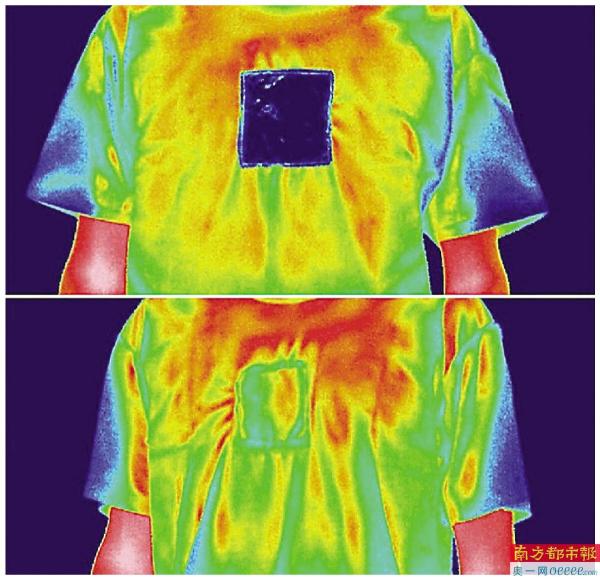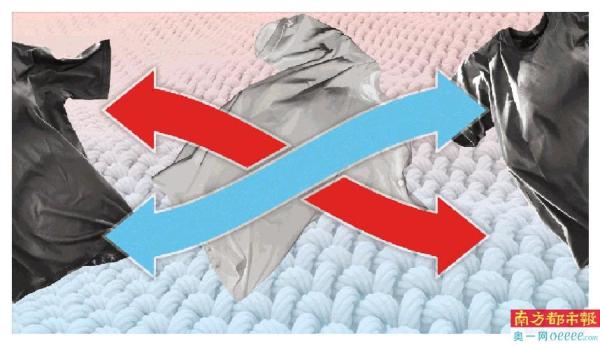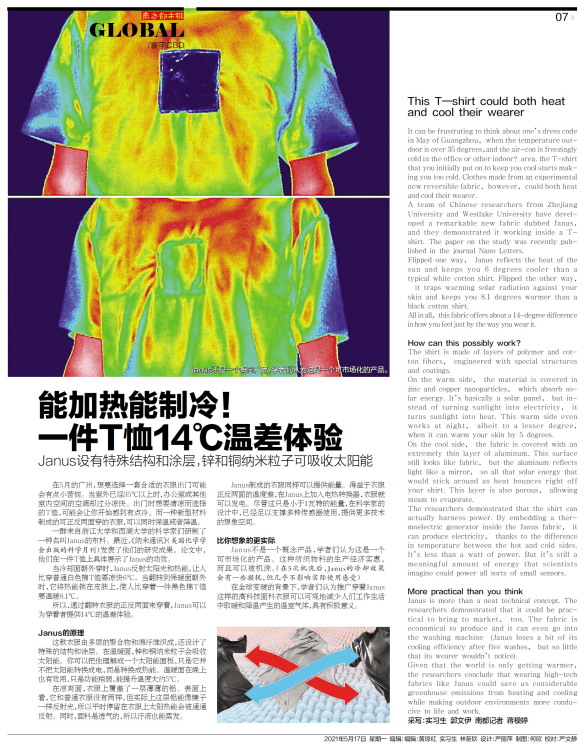
Janus不是一个概念产品,学者们认为这是一个可市场化的产品。

在5月的广州,想要选择一套合适的衣服出门可能会有点小苦恼。当室外已经35℃以上时,办公室或其他室内空间的空调却过分凉快。出门时想要清凉而选择的T恤,可能会让你开始感到有点冷。而一种新型材料制成的可正反两面穿的衣服,可以同时保温或者降温。
一群来自浙江大学和西湖大学的科学家们研制了一种名叫Janus的布料。最近,《纳米通讯》(美国化学学会出版的科学月刊)发表了他们的研究成果。论文中,他们在一件T恤上具体展示了Janus的功效。
当冷却面朝外穿时,Janus反射太阳光和热能,让人比穿普通白色棉T恤要凉快6℃。当翻转到保暖面朝外时,它将热能锁在皮肤上,使人比穿着一件黑色棉T恤要温暖8.1℃。
所以,通过翻转衣服的正反两面来穿着,Janus可以为穿着者提供14℃的温差体验。
Janus的原理
这款衣服由多层的聚合物和绵纤维织成,还设计了特殊的结构和涂层。在温暖面,锌和铜纳米粒子会吸收太阳能。你可以把他理解成一个太阳能面板,只是它并不把太阳能转换成电,而是转换成热能。温暖面在晚上也有效用,只是功能稍弱,能提升温度大约5℃。
在凉爽面,衣服上覆盖了一层薄薄的铝。表面上看,它和普通衣服没有两样,但实际上这层铝能像镜子一样反射光,所以平时停留在衣服上太阳热能会被通通反射。同时,面料是透气的,所以汗液也能蒸发。
Janus制成的衣服同样可以提供能量。得益于衣服正反两面的温度差,在Janus上加入电热转换器,衣服就可以发电。尽管这只是小于1瓦特的能量,在科学家的设计中,已经足以支撑多种传感器使用,提供更多技术的想象空间。
比你想象的更实际
Janus不是一个概念产品,学者们认为这是一个可市场化的产品。这种纺织物料的生产经济实惠,而且可以被机洗。(在5次机洗后,Janus的冷却效果会有一些损耗,但几乎不影响实际使用感受)
在全球变暖的背景下,学者们认为推广穿着Janus这样的高科技面料衣服可以可观地减少人们工作生活中取暖和降温产生的温室气体,具有积极意义。
This T—shirt could both heat and cool their wearer
It can be frustrating to think about one’s dress code in May of Guangzhou, when the temperature outdoor is over 35 degrees,and the air-con is freezingly cold in the office or other indoor?area. the T-shirt that you initially put on to keep you cool starts making you too cold. Clothes made from an experimental new reversible fabric, however, could both heat and cool their wearer.
A team of Chinese researchers from Zhejiang University and Westlake University have developed a remarkable new fabric dubbed Janus, and they demonstrated it working inside a T-shirt. The paper on the study was recently published in the journal Nano Letters.
Flipped one way, Janus reflects the heat of the sun and keeps you 6 degrees cooler than a typical white cotton shirt. Flipped the other way, it traps warming solar radiation against your skin and keeps you 8.1 degrees warmer than a black cotton shirt.
All in all, this fabric offers about a 14-degree difference in how you feel just by the way you wear it.
How can this possibly work?
The shirt is made of layers of polymer and cotton fibers, engineered with special structures and coatings.
On the warm side, the material is covered in zinc and copper nanoparticles, which absorb solar energy. It’s basically a solar panel, but instead of turning sunlight into electricity, it turns sunlight into heat. This warm side even works at night, albeit to a lesser degree, when it can warm your skin by 5 degrees.
On the cool side, the fabric is covered with an extremely thin layer of aluminum. This surface still looks like fabric, but the aluminum reflects light like a mirror, so all that solar energy that would stick around as heat bounces right off your shirt. This layer is also porous, allowing steam to evaporate.
The researchers demonstrated that the shirt can actually harness power. By embedding a thermoelectric generator inside the Janus fabric, it can produce electricity, thanks to the difference in temperature between the hot and cold sides. It’s less than a watt of power. But it’s still a meaningful amount of energy that scientists imagine could power all sorts of small sensors.
More practical than you think
Janus is more than a neat technical concept. The researchers demonstrated that it could be practical to bring to market, too. The fabric is economical to produce and it can even go into the washing machine (Janus loses a bit of its cooling efficiency after five washes, but so little that its wearer wouldn’t notice).
Given that the world is only getting warmer, the researchers conclude that wearing high-tech fabrics like Janus could save us considerable greenhouse emissions from heating and cooling while making outdoor environments more conducive to life and work.
采写:实习生 郭文伊 南都记者 蒋模婷

